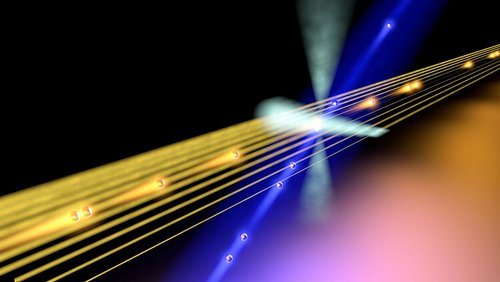An international team of researchers from Leibniz University Hannover and the University of Strathclyde in Glasgow has overturned a long-standing assumption about the impact of multiphoton components on interference effects involving thermal fields (e.g., sunlight) and parametric single photons (produced in nonlinear crystals). This new discovery opens up novel avenues for exploring photonic quantum information systems.
“We were able to experimentally demonstrate that quantum interference with the background field occurs during the interference effect between thermal light and parametric photons. Therefore, the background cannot simply be subtracted or ignored in calculations, as has been common practice,” says Prof. Dr. Michael Kues, head of the Institute of Photonics and a board member of the PhoenixD Cluster of Excellence at Leibniz University Hannover.
The lead researcher was doctoral student Anahita Khodadad Kashi, who studies photonic quantum information processing at the Institute of Photonics. She investigated how the visibility of the Hong-Ou-Mandel effect—a quantum interference phenomenon—is affected by multiphoton contamination. “With our experiment, we disproved the previously held assumption that multiphoton components only reduce visibility and can therefore be subtracted in calculations,” says Khodadad Kashi. She continues: “We discovered a new fundamental characteristic that had not been accounted for in prior calculations. With our newly developed model, we can predict quantum interference and measure the effect experimentally.”
How New Knowledge Emerges
The team made their discovery while conducting an experiment in the laser lab. Initially following the established calculation methods, they encountered a negative result. “But such a result would be physically impossible,” explains Khodadad Kashi. Together, the team began troubleshooting both the experimental setup and the computational model.
“When an experiment yields an unexpected result, scientists start questioning previous assumptions and searching for new explanatory frameworks,” says Kues. The researchers thus developed their new theory on quantum interference between thermal fields and parametric single photons. Quantum physicist Lucia Caspani from the University of Strathclyde in Glasgow was the first to evaluate the approach. Subsequently, Khodadad Kashi presented the theory and experimental results at international conferences, including Photonics West in San Francisco, the world’s largest conference on optics and photonics with approximately 22,000 participants. There, she discussed her model with other scientists and received confirmation of her findings. The results have now been published in the journal Physical Review Letters.
Kues’ team has made a significant contribution to understanding quantum phenomena with their new theory and experimental validation. “These insights could have future implications for quantum key distribution, which is essential for secure communication, particularly in interpreting quantum interference effects to generate secret keys,” says Khodadad Kashi. However, many questions remain open, Kues notes: “Multiphoton effects are still poorly understood and require much further investigation.”
The research was funded by the European Research Council through an ERC Starting Grant (Project: QFreC).
Prof. Dr. Michael Kues is the head of the Institute of Photonics and a board member of the Cluster of Excellence PhoenixD: Photonics, Optics, and Engineering - Innovation across Disciplines at Leibniz University Hannover. The PhoenixD research cluster comprises more than 120 scientists working on novel integrated optics. PhoenixD is funded by the German Research Foundation (DFG) with approximately €52 million from 2019 to 2025.

